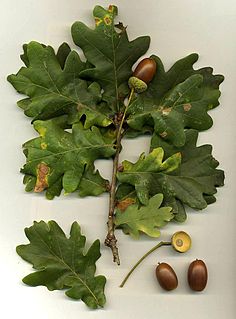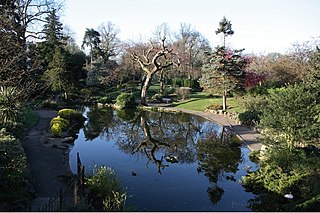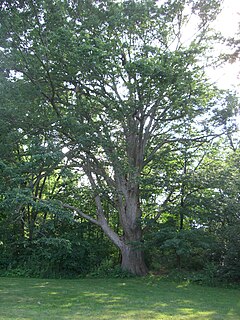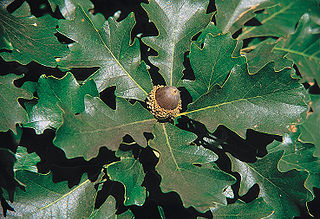The Verdun trees are oak and horse chestnut trees, planted in the United Kingdom in the aftermath of the First World War. Acorns and chestnuts were collected from trees on the battlefield at Verdun, and sent to England to be distributed and planted as war memorials. Some were sold by the London and North Western Railway in 1917 to raise money for the War Seal Foundation, founded by Oswald Stoll. Others may have been brought back to the UK by Field Marshal Lord French.

An oak is a tree or shrub in the genus Quercus of the beech family, Fagaceae. There are approximately 600 extant species of oaks. The common name "oak" also appears in the names of species in related genera, notably Lithocarpus, as well as in those of unrelated species such as Grevillea robusta and the Casuarinaceae (she-oaks). The genus Quercus is native to the Northern Hemisphere, and includes deciduous and evergreen species extending from cool temperate to tropical latitudes in the Americas, Asia, Europe, and North Africa. North America contains the largest number of oak species, with approximately 90 occurring in the United States, while Mexico has 160 species of which 109 are endemic. The second greatest center of oak diversity is China, which contains approximately 100 species.

The Battle of Verdun, was fought from 21 February to 18 December 1916 on the Western Front. The battle was the longest of the First World War and took place on the hills north of Verdun-sur-Meuse in north-eastern France. The German 5th Army attacked the defences of the Fortified Region of Verdun and those of the French Second Army on the right (east) bank of the Meuse. Using the experience of the Second Battle of Champagne in 1915, the Germans planned to capture the Meuse Heights, an excellent defensive position with good observation for artillery-fire on Verdun. The Germans hoped that the French would commit their strategic reserve to recapture the position and suffer catastrophic losses, at little cost to the Germans.

The London and North Western Railway was a British railway company between 1846 and 1922. In the late 19th century the L&NWR was the largest joint stock company in the United Kingdom.
Queen Mary planted a Verdun oak on the Sandringham Estate in Norfolk on 28 January 1920. Two Verdun oaks were planted in the Royal Botanic Gardens, Kew on Peace Day, 19 July 1919; one remains, but the other was removed in 2014.

Mary of Teck was Queen consort of the United Kingdom and the British Dominions and Empress consort of India as the wife of King George V.

Royal Botanic Gardens, Kew is a non-departmental public body in the United Kingdom sponsored by the Department for Environment, Food and Rural Affairs. An internationally important botanical research and education institution, it employs 1,100 staff. Its board of trustees is chaired by Marcus Agius, a former chairman of Barclays.
Other Verdun oaks remain in:
- the War Memorial Park, Coventry and in Spencer Park, Coventry
- Queens Park, Crewe, Cheshire (probable)
- Pembridge, Herefordshire
- Southwold, Suffolk;
- Grange Park, Leominster
- Beaumont Park, Huddersfield, where there are two examples
- Corby Castle, Carlisle
- Forbury Gardens, Reading
- near Hale War Memorial, in Surrey

The War Memorial Park is a large park of about 48.5 hectares in southern Coventry, England. The park was opened in July 1921 as a tribute to the 2,587 Coventrians who died between 1914 and 1918 fighting in the First World War. The landscaped gardens and sports areas were created in the late-1920s and 1930s, and the most prominent structure in the park is the city's war memorial monument, built in 1927.

Queens Park in Crewe, Cheshire, is a Grade II* listed public park opened in 1887, little changed from its original plan. It was laid out by railway engineer Francis Webb, Richard Moon, mayor of Crewe in 1888, and garden designer Edward Kemp.

Pembridge is a village and civil parish in Arrow valley in Herefordshire, England. The village is on the A44 road about 6 miles (10 km) east of Kington and 6 1⁄2 miles (10.5 km) west of Leominster. The civil parish includes the hamlets of Bearwood, Lower Bearwood, Lower Broxwood, Marston, Moorcot and Weston. The 2011 Census recorded the parish population as 1,056.
There are also Verdun horse chestnuts in Beaumont Park, Huddersfield, and one horse chestnut – reportedly from a group of twenty – was planted in St Albans in January 1976.

Beaumont Park is a suburb of Huddersfield, in the Metropolitan Borough of Kirklees, West Yorkshire, England that is located between Netherton, Crosland Moor and Lockwood.

St Albans is a city in Hertfordshire, England and the major urban area in the City and District of St Albans. It lies east of Hemel Hempstead and west of Hatfield, about 20 miles (32 km) north-northwest of central London, 8 miles (13 km) southwest of Welwyn Garden City and 11 miles (18 km) south-southeast of Luton. St Albans was the first major town on the old Roman road of Watling Street for travellers heading north, and it became the Roman city of Verulamium. It is a historic market town and is now a dormitory town within the London commuter belt and the Greater London Built-up Area.
There are believed to be many other Verdun trees whose locations are not certain, including trees in Walpole Park, Ealing, and in Whitehaven and Swansea.

Walpole Park is a municipal urban public open space run by London Borough of Ealing Council. Its main entrance is situated in the Mattock Lane, Ealing, West London.

Whitehaven is a town and port on the west coast of Cumbria, near the Lake District National Park in England. Historically in Cumberland, it lies by road 38 miles (61 km) south-west of Carlisle and 45 miles (72 km) to the north of Barrow-in-Furness. It is the administrative seat of the Borough of Copeland, and has a town council for the parish of Whitehaven. The population of the town was 23,986 at the 2011 census.

Swansea is a coastal city and county, officially known as the City and County of Swansea in Wales. Swansea lies within the historic county boundaries of Glamorgan and the ancient Welsh commote of Gŵyr on the southwest coast. The county area includes Swansea Bay and the Gower Peninsula. Swansea is the second largest city in Wales and the twenty-fifth largest city in the United Kingdom. According to its local council, the City and County of Swansea had a population of 241,300 in 2014, the second most populous local authority area in Wales after Cardiff. Together with Neath and Port Talbot, Swansea formed a wider Urban Area of 300,352 in 2011.
Some Verdun trees have been removed, including one at Upton Lawn, Cheshire and one at Moorcourt Estate, Pembridge. An original Verdun oak tree in the Garden of Remembrance, Lichfield was later replaced by a tree grown from one of its acorns.

Lichfield is a cathedral city and civil parish in Staffordshire, England. Lichfield is situated roughly 16 mi (26 km) north of Birmingham, 9 miles (14 km) from Walsall and 13 miles (21 km) from Burton Upon Trent. At the time of the 2011 Census the population was estimated at 32,219 and the wider Lichfield District at 100,700.
With the original trees approaching 100 years old, the Woodland Trust launched a project in 2016 to grow a second generation of Verdun trees.















